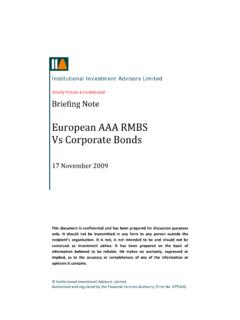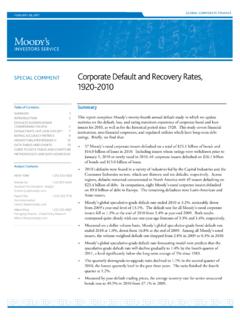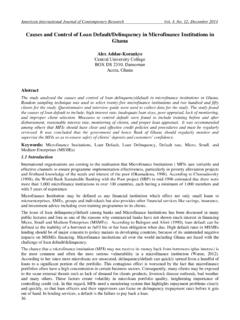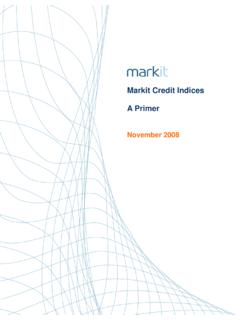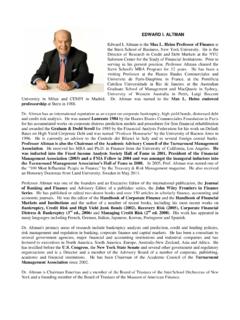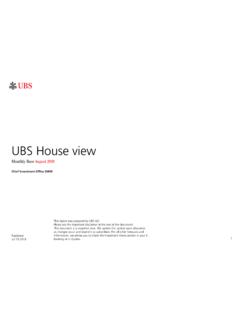Transcription of Senior secured loans - Institutional Investment …
1 Institutional Investment Advisors Limited Briefing Note for Institutional Investors Investment Case for Senior secured loans February 2011. This report provides general information only and is intended for use exclusively by Institutional investors or market professionals. It is not, is not intended to be and should not be construed as Investment advice. It has been prepared on the basis of information believed to be reliable. IIA makes no warranty, expressed or implied, as to the accuracy or completeness of any of the information or opinions it contains. Please refer to the important notice at the end of this report. Institutional Investment Advisors Limited Authorised and regulated by the Financial Services Authority (Firm No. 475344). Contents Summary of the Investment Key Features of Senior secured loans ( SSLs')..4. Comparison of loans and High Yield Market Performance of Senior secured Investment Structures.
2 12. Manager Outlook for Senior secured loan Summary & Conclusion ..18. 2. Summary of the Investment Case Risks Senior secured loans ( SSLs' also referred to as leveraged loans ) form part of the high yield debt sector and tend to have credit ratings in the BB/B range, largely reflecting the significant debt financing of the borrower rather than the quality of the underlying business. Senior secured loans have attractive risk features when compared with other high yield alternatives: o There is a significant cushion of junior obligations and security to protect against risk of loss from borrower defaults. o The Senior secured nature of SSLs means that recovery rates tend to be significantly higher than on high yield bonds. o SSLs are usually floating rate instruments and as such they offer protection against any upward shifts in interest rates (and potentially inflation). Institutional leveraged loan market defaults spiked in 2009 at (by value) in the US.
3 And at in Europe. In 2010 defaults declined to in the US and in Europe. Recovery rates on SSLs are relatively high, the 1995-2010 average was 71% in the US and 66% in Europe for 2000-2010, due to the primary position of the loans in the capital structure and their secured nature. The market has to confront a significant volume of re-financing, particularly in the 2013-16. period, but confidence in the ability of the market to absorb this volume has been rising on the back of positive re-financing activity in 2010. Returns Secondary market spreads on Senior secured loans offer attractive risk- adjusted returns. SSLs are currently trading at around LIBOR + 400bps in the US and EURIBOR + 480bps in Europe. Spreads are still reflecting a market dislocation premium that has arisen as a result of the withdrawal from the market of leveraged buyers, and whilst these spreads have been narrowing, they still offer good risk-adjusted value, given the expectations of a decline in borrower defaults.
4 Post credit crunch, new primary market issuance has provided investors with significantly better all-in spreads (400-500bps in the US compared with 200-225bps pre-credit crisis). and improved protection, as deals are now being structured with less leverage. The combination of funding pressures and increased regulatory capital charges on banks has provided an opportunity for certain loan arrangers to step into the breech and take on an origination role, which offers investors the prospect of sharing in the benefits of arrangement fees and other economically attractive features, such as LIBOR floors. 3. Key Features of Senior secured loans ( SSLs'). SSL's are usually secured by all tangible and intangible assets of the borrower. Typically used to finance acquisitions, leveraged buy-outs ( LBOs'), or as a means to recapitalise an existing corporate entity. Often referred to as leveraged loans . Senior secured loans are generally: o Non- Investment grade assets (generally rated BB or B, usually privately rated in Europe).
5 O Floating interest rate (LIBOR / EURIBOR linked). o Private instruments which provide for a significant amount of due diligence and disclosure to lenders. Senior secured loans (also referred to as first lien loans ) occupy the highest position in a borrower's capital structure: Class Ranking Senior secured loans Highest Senior secured bonds Senior unsecured bonds Mezzanine loans High yield subordinated bonds Equity Lowest o Debt ranks first in order of payment as matter of law, with equity occupying the most junior position in the seniority structure. o We have ranked Senior secured bonds below SSLs, as although they may be advertised as ranking pari passu, often the bonds will have a weaker security or guarantee package and/or lesser security enforcement rights. o Around 45 - 55% of leverage buyout financing is subordinate to the Senior secured loans providing a significant margin of safety as illustrated in the following table: Seniority % of financing Subordination Senior debt 55-45% 45-55%.
6 Subordinated Debt 15-20% 25-35%. Equity 25-35% Nil o SSLs have a first ranking claim on security proceeds which are usually secured directly on the assets of the operating company. Extensive covenant packages in the loan documentation provide protection for if they are breached lenders can enforce corrective action. Original legal lives are typically between 5 and 9 years. However, prepayment flexibility is provided to borrowers and no penal make-whole early termination premium is payable, unlike for a typical high yield bond. This flexibility means that borrowers find it more attractive to retire SSLs early and this debt amortisation provides additional risk reduction for SSL investors. 4. Comparison of loans and High Yield Bonds The following table provides a summary of the key differences between SSLs and the closely associated asset class, high yield bonds: Senior loans High yield bonds Payment 1st ranking for payment Structurally subordinated Security 1st claim on security Usually none Covenants Generally comprehensive Less restrictive Information Access to confidential information such as monthly Limited to publicly available financial accounts & financial projections information Term 5 to 9 years 7 to 10 years Income Fixed spread over LIBOR/EURIBOR Fixed coupon Pre-payment Moderate pre-payment penalty on longer-dated 5 year non-call widespread use of deals heavy make whole penalties Ratings /listing Usually privately rated in Europe, publicly rated in Publicly rated & listed on a recognised USA.
7 Unlisted. Not UCITS eligible. stock exchange. UCITS eligible. Whilst the returns offered by the two asset classes are comparable on an asset swap basis 7 year high yield bonds are currently trading at around EURIBOR/LIBOR + 470 - 500bps compared with 5 year SSLs which are yielding LIBOR/EURIBOR + 400 - 480 bps the all round seniority and security package offered by SSLs is far stronger. SSLs are typically secured on the assets of the operating company, whilst high yield bonds are often structurally subordinated because they are issued at the holding company level. Partly due to this factor, recovery rates on loans have historically exceeded those on high yield bonds. Hence, on a risk-adjusted basis, SSLs are more attractive than high yield bonds. Secondary markets exist for both high yield bonds and Senior secured loans , and as with both types of debt instrument, liquidity is best in the larger flow names.
8 If SSLs are so much stronger in structure and performance, why are they offering similar spreads to HY bonds? A good part of the answer is technical. While many loans are transferable and traded, loans generally do not meet the UCITS definition of "transferable security" and are therefore, despite the greater credit protection afforded to SSL lenders, not eligible for UCITS. The large European retail investor base, whether directly or via "linked" funds with insurance companies, invests predominantly via UCITS. As a result, high yield bonds that are UCITS eligible tend to be overbought, relative to loans with equivalent or better credit fundamentals, in a bullish credit market hungry for yield. 5. Market profile In leveraged loan financings the short-term Revolving Credit and Term loan A facilities are generally provided by banks, whilst the longer dated Term loan B and C facilities are the elements of the financing package that are usually offered to Institutional investors, and so are referred to as Institutional loans .
9 A market in Institutional leveraged loans has existed in the US since the early 1990s, with the European market only getting underway at the turn of the century. Until this time the debt was largely retained by the banking sector. Institutional loan outstandings in the US grew rapidly between 2003 07 to over $840 billion. In Europe growth was also dramatic during this period with outstandings rising to over 200billion by 2007. 1. The credit crunch considerably disrupted the Institutional loan markets, with huge falls in new loan volumes globally and a reduction in total market size in the US, with Europe experiencing a slower decline in total outstandings. Volumes began to recover in 2010. The outlook for the market is discussed in more detail later on. The following chart shows the evolution of the market in the US: US Institutional Leveraged loan Market Source: Credit Suisse 1000. 400. loans outstanding $bn 800.
10 New loans $bn 300. 600. 400 200. 200 100. 0 0. 03. 08. 93. 94. 95. 96. 97. 98. 99. 00. 01. 02. 04. 05. 06. 07. 09. 10. 19. 19. 19. 19. 19. 19. 19. 20. 20. 20. 20. 20. 20. 20. 20. 20. 20. 20. Outstanding amount New loans (RHS). The chart below summarises the picture in Europe: Western European Institutional Leveraged loan Market Source: Credit Suisse 250 125. loans outstanding EUR bn 200 100. New loans EUR bn 150 75. 100 50. 50 25. 0 0. 1999 2000 2001 2002 2003 2004 2005 2006 2007 2008 2009 2010. Outstanding amount New loans (RHS). 1. Source: Credit Suisse 2011 Leveraged Finance Outlook and 2010 Annual Review Jan 2011. 6. Performance of Senior secured loans Credit US leveraged loan default rates by value have averaged 4 - 6% per annum and 3 - 5% by number as shown in the following table: US Leveraged loan Default Rates Annual Default rate by Default rate by Volume $ bn Number Averages value issuer Last 3 years $ 61 Last 5 years $ 38 Last 7 years $ 30 Historical $ 24 Source: J P Morgan, S&P LCD.
